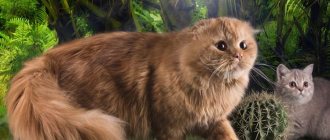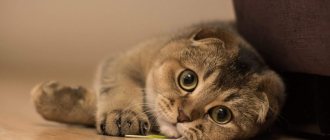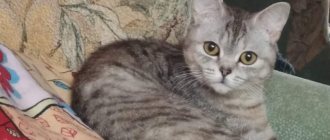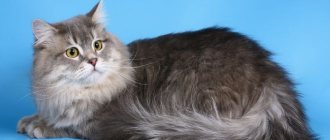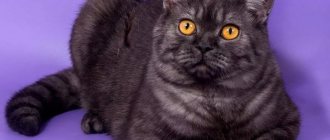These cats appeared relatively recently and were not recognized as a separate breed for a long time. The “British” were already proudly walking around the apartments, admiring their aristocratic appearance, and the “Scots”, who owed their birth to a spontaneous mutation, were not yet known to the general public.
Many consider only cats with floppy ears to be “Scottish”, while straight-eared cats are classified as a British breed. This is fundamentally wrong, since the British cat and the Scottish Straight are two completely different breeds.
History of the origin of the breed
It is known that all “Scottish” kittens are born with straight ears, but by six months, some have ears that remain sticking out above their heads, like most other cat breeds, while others are nicely pressed against their heads. It is incorrect to believe that a Scottish cat with regular ears was first bred, and then the trait of lop ears was achieved. In this case, nature played a trick on man and turned back progress.
In 1961, on a farm in Scotland, a young cat, Susie, was seen with her ears turned down. The sign was also preserved in her kittens. Subsequently, a new breed was registered - the Scottish Fold. Unfortunately, when crossing fold-eared cats with each other, life-threatening deformations of the animal's skeleton appeared, as a result it was necessary to crossbreed with British relatives. From this mating, kittens were born, some of which had their ears drooping as expected, but some remained straight-eared.
Despite the fact that fold-eared kittens are considered more valuable, elite and cost more, “straights” are necessary in order to maintain a special trait of the breed, which is actually a flaw.
Initially, fold-eared cats were recognized as a separate breed, and their straight-eared counterparts were classified as British. It was only in 2004 that the World Cat Federation (WCF) registered them as a separate breed - the “Scottish Shorthair”. Since then, Scottish Straights have been admitted to exhibitions.
What other factors influence the price of a Scottish fold cat?
In addition to the breeding value class, a number of other criteria influence how much a Scottish Fold or Straight kitten costs.
Availability of documents indicating the origin and confirming belonging to the breed
Today there is more than enough, however, all that glitters is not gold.
Scottish Straight cat (Scottish Straight)
The presence of curled ears does not associate the animal with the “Scots”. In addition to the unusual structure of the auricle, there are a number of characteristics that distinguish the Scottish kitten from its fellows. You should not save money in such a responsible choice, so as not to get a matured yard cat Vaska, and not the desired handsome fold-eared cat.
It’s better to overpay a little and get a healthy purebred handsome dog, which will definitely save nerves and, possibly, money in the future!
Unscrupulous breeders also do not pay enough attention to the rules of crossing and, as a result, the health of the offspring, which is an important component of a comfortable life with a cat. ▲ to contents
Fold-eared (Scottish Fold) or straight-eared (Scottish Straight) pet
The Scottish cat is distinguished not only because of its “broken” ears: their unusual, slightly surprised faces also attract buyers. In addition, a Scottish Straight will cost less than a fold-eared kitten. Their cost starts at $100 and, again, depends on other external characteristics, such as the color and length of the coat, the expressiveness of the eyes, etc.
The straight-eared Scottish representative will certainly not be at risk of developing problems with the musculoskeletal system due to the absence of the “folding” gene, which is responsible for the “curling” of the ears, unlike the Scottish Fold cat.
▲ to contents
General characteristics of the breed
At first they were confused - “British” and “Scots”. However, in appearance they are completely different: British cats (and especially male cats) are distinguished by strong bones and large bodies. The Scottish cat has a more open muzzle, no expressive cheeks, and the look of its large round eyes is not so stern. In general, "Scottish" cats do not look as heavy and powerful as British cats.
Appearance
According to breed standards, the Scottish Straight cat has:
- the body is medium-sized, shorter and not as squat as that of a British cat;
- a noticeably rounded head, gradually turning into a neck;
- convex, but with signs of rounding forehead;
- well developed chin;
- large expressive eyes;
- wide, oblong nose.
The Scottish Straight's limbs are medium in size, its tail is wide, slightly tapering towards the tip. Add to this the soft, feather-like fur that is pleasant to the touch. In straight-eared kittens, it can be either short or long.
The cuteness of the muzzle is given by a small “dimple” at the base of the nose, between the eyes. Because of this feature, the cat looks a little proud.
The main advantage of the Scottish Straight is its ears. Medium-sized or small, neat, they are located high on the head, spaced relative to each other, but ears that are too wide, like those of a British cat, are considered a breed defect. The tips of the ears are slightly set aside and slightly rounded.
"Scottish" cats have expressive eyes. They are wide open, and the look, especially in small kittens, seems surprised. The color of the iris depends on the color of the coat. Kittens are born with blue eyes, and only by four months can you understand what they will be like. Adult Scottish cats may have eyes that are:
- blue;
- green;
- golden;
- amber;
- copper;
- orange;
- brown.
For breeders, it may be important what color the animals will be, so it is not recommended to pick up kittens early, less than four months of age.
Breed standards allow for a variety of coat colors in Scottish Straight cats. A thick plush coat can be plain, marble, or tortoiseshell. Popular colors:
- black;
- chocolate;
- white;
- lilac;
- black smoke;
- tabby;
- marble on silver (“whiskas”).
The cost of a Scottish Straight kitten largely depends on the coat color. The rarest and most valuable color is lilac, the most popular is chinchilla, marble on gold or marble on silver.
Breeding value classes of Scottish kittens, and how the cost varies within them
Will the kitten become an exclusively house friend or does the owner dream of showing off the beauty of his pet at shows? The class level to which the future pet will belong depends on this.
- “Scots” are divided into 3 classes of breeding value: PET-, BRID- and SHOW-.
- The PET class is suitable for a person who wants to enjoy a cute pet at home. A PET-class kitten will not be able to participate in exhibitions and build an exterior “career”. Such a pet is not intended for further breeding, but will certainly become a full-fledged member and favorite of the whole family! The price of a Scottish fold cat varies between $150-350 and depends on the color. Due to their prevalence, an individual with a classic blue color will cost less ($150-200), more expensive - the more remarkable “chinchilla”, “marble”, “harlequin”, “van” (about $300), for a pet in the color “cinnamon” "or "gold" the price will increase significantly (from $500). All possible color variations of the Scottish cat are presented here.
- Assigning a cat to the BRID class gives it the right to participate in exhibitions and receive initial assessments. As a rule, a BRID-class animal has minor breed deviations, which gives the owner the right to breed and get excellent offspring, perhaps even SHOW-class (with proper crossing). This class is recommended for beginning breeders for breeding work. Tariffs start from $350-400 and range up to $700-800, depending on the color.
- SHOW-class kittens are destined to become stars of exhibitions and participate in the continuation of their breed, endowing their offspring with the best qualities. It is worth considering that the same “correct” kittens are not always born when crossing SHOW-class cats. Often this is a maximum of 1-2 representatives from the entire litter. The price starts at $500 and sometimes reaches $2000!
▲ to contents
Character
Scottish Straights are distinguished by their flexible character. They are very smart and not aggressive. Cats quickly become attached to the house and to their owners, having chosen one favorite. They do not like to be left alone and, if possible, are not averse to jumping into a person’s arms. At the same time, they will not impose their company if they see that the owner is not inclined to communicate.
New people in the house do not scare them, although sometimes cats want to be sad alone, then they climb into a quiet place. The voice of the Scottish Straight can not be heard often, they do not hysteria, do not meow loudly, except when begging for a treat.
The owner does not have to worry about the safety of the furniture and the cleanliness of the carpet: “Scottish dogs” are very clean and polite, they quickly get used to the tray and scratching post and indifferently walk past the soft sofa without putting their claws into it.
Straight-eared “Scots” easily get along with children and other animals, without showing any aggression or jealousy. They easily tolerate moving, changing home, familiar surroundings, and if due to circumstances they are forced to change owners, they quickly adapt to the new environment.
In a word, cats of this breed can be called ideal. The main thing is that there is food in the bowl and favorite toys on the rug.
Buy a Scottish or British kitten
In our nursery you can buy a Scottish breed kitten. This playful fluffy little ball will not leave anyone indifferent, which is why the Scottish cat has won the hearts of many people. The unique character of this breed is completely devoid of aggression at the genetic level, and its unique trait - sociability without intrusiveness - can satisfy even the most demanding person. In addition to these undeniable positive qualities, the Scottish cat is also affectionate, elegant and loyal. This breed is not noisy and neat. The Scottish cat is friendly towards other pets, has a soft character and a gentle nature. She is always patient and loving, even towards naughty children. Therefore, if you decide to buy a kitten of the Scottish breed, you should not worry that your family’s life will change radically. No, you will get only positive emotions from buying a Scottish kitten.
In the Foldlandia nursery you can not only buy a kitten, but also buy a Scottish cat, as a breeder or who has already completed her breeding career. This option is perfect for busy people who want to buy a Scottish cat that has already been trained in all the tricks of the cat, with consistently good manners, ready for breeding or already sterilized. After all, an adult Scottish cat is already smart enough and no longer needs your constant monitoring of it. She will perfectly understand both your intonation and read your thoughts. She will listen to every word addressed to her. Sometimes the rhythm of life of a modern busy person does not allow him to devote a sufficient amount of time to Scottish kittens and raise them - the optimal solution in such a situation is to buy an adult Scottish cat.
In addition, the Foldlandia nursery breeds a second, but no less popular breed - the British Shorthair. Therefore, in our nursery you can also buy a British kitten. The British kitten will no less impress you with its beauty. He has unique beautiful plush fur and a truly aristocratic appearance. British kittens have a calm disposition and are not an active breed of cat. They stroll around the house imposingly, and do not bother you with their screams or demands. British kittens quickly get used to order and try to adhere to it throughout their lives. The British kitten is owner-oriented; it becomes attached to its owner, despite the fact that it values its personal space and independence. Be sure that if you decide to buy a British kitten, he will give your family a lot of positivity and positive emotions in the process of communicating with him.
If your plans include breeding British cats, you can buy an adult British cat in our nursery. This will be the best guarantee that the already adult British cat has no defects, since some defects may go unnoticed when purchasing a kitten with breeding rights. Of course, an adult British cat will cost more, but at the same time you will save money on raising it and time. In addition, some people who want to buy a British kitten are afraid that they will not be able to cope with caring for and raising the baby. In this case, it makes sense to trust a professional breeder and buy an adult British cat raised and trained professionally.
If you want to buy a Scottish or British kitten, or an adult British or Scottish cat of a rare color, please contact us, we will select your best friend depending on your preferences.
Care and maintenance, nutrition
Scottish Straights cannot be called demanding; they are one of the most unpretentious breeds, but every pet needs attention and care. Then you can admire their well-groomed appearance, silky fur, and excellent health.
Once a week you need to comb the fur with a sparse comb and a natural bristle brush. In spring and autumn, during seasonal molting, you will have to comb out more often, using a special combing glove with a rubber pad.
There is no need to bathe straight-eared Scottish cats often: they are clean and take care of themselves on their own. And they, like many representatives of the cat family, do not like water, so it is undesirable to expose them to stress. To care for the fur, you can use dry shampoo, which is applied to the body and then combed out. It was good for the cat and didn’t make me nervous.
But the eyes require special care. Due to the special structure of the muzzle, Scottish Straights may experience frequent tearing. It is better to remove tears with a dry cloth or soft cloth. Water and wet wipes can be harmful.
Inspect your cat's ears regularly; you can clean them with cotton swabs or instill special ear drops that are sold in a pet store. The drops will soften the plaque, and the cat will not experience discomfort during hygiene procedures.
Your cat's teeth will remain healthy if you regularly offer her dry food, chew sticks, and toys. Thanks to them, teeth self-clean, which helps protect them from plaque and tartar formation. You can purchase a special toothpaste and brush and brush your cat’s teeth at least once a week.
It is strictly forbidden to remove a cat's claws, but caring for them is necessary. From an early age, accustom your kitten to a scratching post, trim its claws regularly by purchasing a special nail clipper. Kittens need to carry out manipulations twice a month, adult animals – monthly. You need to trim the claws carefully, without touching the pink part, where the blood vessels are close to the skin.
Nutrition of Scottish Straights
The cat's diet should be balanced. Natural products or ready-made industrial feeds of at least premium class must contain the required amount of proteins, fats, vitamins, minerals and amino acids. Meat as the main source of protein should make up at least 80% of the total diet. Poultry, rabbit, and beef are best suited. It is recommended to give your cat offal once or twice a week. You can’t give them raw – only boiled. Every week you need to give your cat low-fat sea fish: it is rich in omega-3 fatty acids necessary for the cat’s body.
Cats need plant foods. Vegetables can be given raw or boiled, mixed with meat. Of the fermented milk products, those with low fat content are acceptable, but milk is only allowed for kittens up to 3 months of age; later, animals develop lactose intolerance. You can feed your cat well boiled ones. Add a boiled chicken egg yolk to your food twice a week.
All foods from your table are prohibited for your cat because they contain salt and spices. You should not give fish with bones, potatoes, bread, legumes, which can harm the cat’s digestive system.
The diet will depend on the age of the animal:
- kittens up to six months of age are fed up to 4 times a day;
- from 6 to 12 months – three times a day;
- After a year, you can switch your cat to two meals a day.
Health and education
Scottish Straights do not have any special genetic diseases: they are distinguished by strong immunity and, with proper care, will please the owner for at least 15 years. However, the key to a cat’s health and longevity is caring for the animal. It is necessary to undergo regular examinations by a veterinarian, timely vaccinations, and preventive treatments for internal and external parasites.
A balanced diet is an important factor affecting the health of a pet. Vitamins and minerals, taurine and biotin, omega-3 fatty acids should be included in the feed, and when feeding “natural” vitamin complexes should be added to the food. They will also take care of the pet’s digestive system and make the fur shiny.
You need to raise a kitten as soon as it gets into your home. Despite their easy-going nature, kids can be capricious and touchy. But the kitten must learn the concept of “impossible”: this way the floor will remain clean and the furniture intact. You need to educate with words, not shouting, and especially not spanking.
Vaccinations
The key to a cat's health is timely vaccination. The very first vaccination is given to kittens at two months of age. Before vaccination, treatment is carried out against fleas and helminths. A comprehensive vaccine will protect your pet from life-threatening diseases: distemper, rhinotracheitis, calcivirosis and chlamydia. After two to three weeks (depending on the vaccine), revaccination is carried out by adding the rabies vaccine. Then vaccinations will be required annually.
Kitten selection criteria
You should choose a kitten taking into account the breed standards. All small kittens of the Scottish breed have straight ears, and what they will be like will become clear in a few months. You shouldn’t take a kitten to a new home too early: with mother’s milk, kittens receive the necessary nutrients that strengthen their immune system.
In order for the offspring to be healthy, breeding rules must be followed. And if you were told that the kitten’s father is a “purebred British” and his mother is a “Scottish” fold, the kitten is unlikely to grow up healthy. Mating a Scottish cat is only possible with a representative of the same breed - a “Scottish cat”. Alas, there are often unfortunate breeders who think only about profit and not about the health of the animals.
Price
As with other purebred animals, the price for Scottish Straight kittens will depend on the pedigree, titles of the parents, and color. The average price of straight-eared “Scots” in nurseries is 8,000 rubles, but recently there have been more advertisements for the sale of purebred kittens, and the price of popular colors is falling, reaching 3-4 thousand rubles.
When buying a kitten, pay attention to its appearance and behavior. Discharge from the eyes, ears, lethargy, dull fur indicate that the animal may not be entirely healthy. Be sure to ask the seller for the kitten’s veterinary passport, confirming that the baby is healthy and vaccinated against dangerous diseases. Then, with proper care, it will delight you for many years.
Photo gallery of Scottish Straights:
1111
How much does a Scottish Fold and Straight-eared cat and kitten cost?
The price of Scottish Straight and Fold cats can be very different, and it depends on many factors. How much does Scottish Straight, Scottish Fold, Highland Straight and Highland Fold cost?
MAIN THOUGHTS OF THE ARTICLE
► prices for Scottish fold and straight-eared kittens vary greatly;► the cost depends on the nursery and the breed characteristics of the animal;
► the price depends on whether the pet is purchased for breeding or for the hobby;
► a person without experience will not be able to determine the quality of a kitten on their own, but we will teach you how to do this at least superficially.
Anticipating the question, let's say that no one gives such kittens for free, unless the cat is a problem and they keep silent about it. Even the frailest cats with weakly expressed breed qualities cost no less than $50. Let's warn you right away: for this price you will buy almost a street dog (see photo below), but it will look a little like a Scotsman. Fold kittens are inexpensive - these are mixed-breed or outbred kittens, similar in appearance to Scots. After all, folded ears are not a guarantee of a pure breed. If you don’t care what breed your cat will be and what its appearance will be, maybe it’s better to get a mongrel cat?
Article continues after advertisement
Look at these kittens: do you like them?
If you were surprised that they were also Scots, don't be surprised. This is the result of a lack of selection and low-quality genes; genes from other breeds are mixed in somewhere, and many cats are not related to the Scots at all. Don't look very good, huh? But they should look like this (see below).
Now look at these - real Scottish bear kittens
On average, straights are always cheaper than their fold-eared counterparts. But there are also straight ones that are more expensive than lop ones. For folds, the shape of the ears is of great importance. The ears can fit well - such kittens are more expensive, but poorly, as if sticking out over the head - such kittens are cheaper.
Prices for kittens, which are outstanding representatives of the breed, but not top ones, start at plus or minus $250. Kittens come in three classes - pet (pet (pet, subject to sterilization, a pedigree is not issued for it), breed (for breeding) and show (highest class). The same cat can be sold as a pet or as a breed, depending on the buyer’s goals. If you need a Scottish cat for your soul, then the price for a good cat will start at $250, as we have already said. But the same kitten as a breed costs 2 times more.
Many people buy a kitten as a pet, but then do not castrate it, but mate it and get kittens that do not have documents, but nevertheless have good breed qualities. This is how people cheated and saved money. This step is considered fraud. We want to warn you against this. Ultimately, such actions lead to the deterioration of the breed.
On average, a very good breed-class kitten as a pet costs about $500. This is the kind of kitten that, even if you sterilize and don’t make money, will become your pride. The cost of a Scottish cat is greatly influenced not only by its class, but also by the rarity of its color. Kittens of rarer colors, such as precious ones, will cost more.
In Ukraine there is an official service for the sale of purebred kittens and puppies from lapa.shop nurseries. When choosing a kitten here, you can be sure of its purebred and the cleanliness of the seller.
KITTENS FOR SALE AT LAPA.SHOP
Article continues after advertisement
The most expensive Scottish cats that we came across on breeders' websites cost an average of about $1,000, but the price can reach up to $2,000. These are show-class cats that are purchased for business.
To understand where and at what price you will buy a kitten, you must first decide on your goals. If a cat is just for the soul, you can buy a pet class. If the goal is business, then only a kitten with a document of origin, and you need to choose meticulously. In the case of the business purpose of purchasing a Scottish cat, you can even fork out $1,000. What other business can you start with such a small starting capital?
Incredible, but true: sometimes you can get a very purebred Scottish cat for free. This is possible if he is already old and the breeder is no longer going to mate him. You can also get a young animal if the breeder initially kept it for breeding, and then something went wrong and they decided to castrate it. Due to the renovation of the nursery, good cats can be obtained absolutely free of charge or for a nominal fee.
Rate and share!



